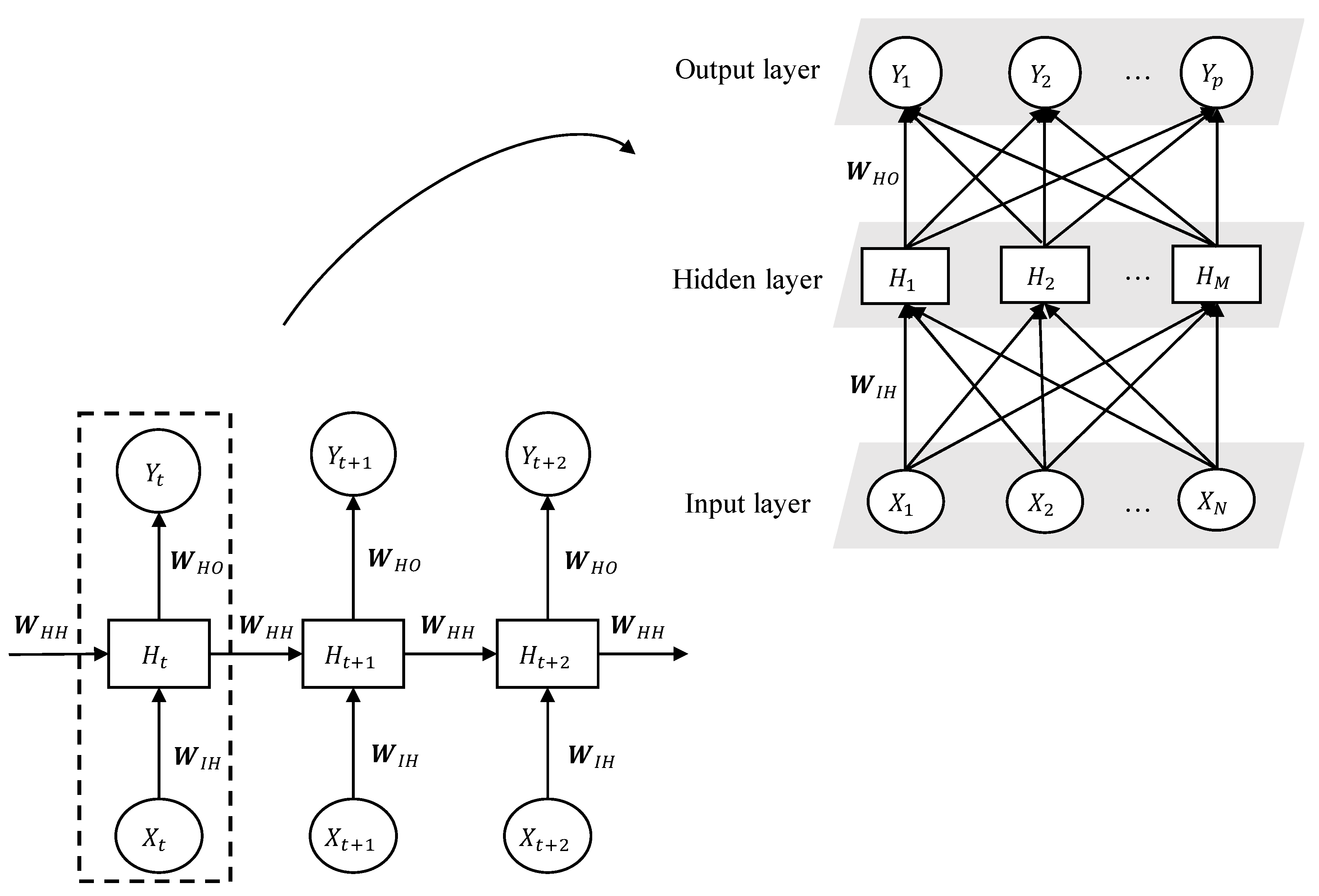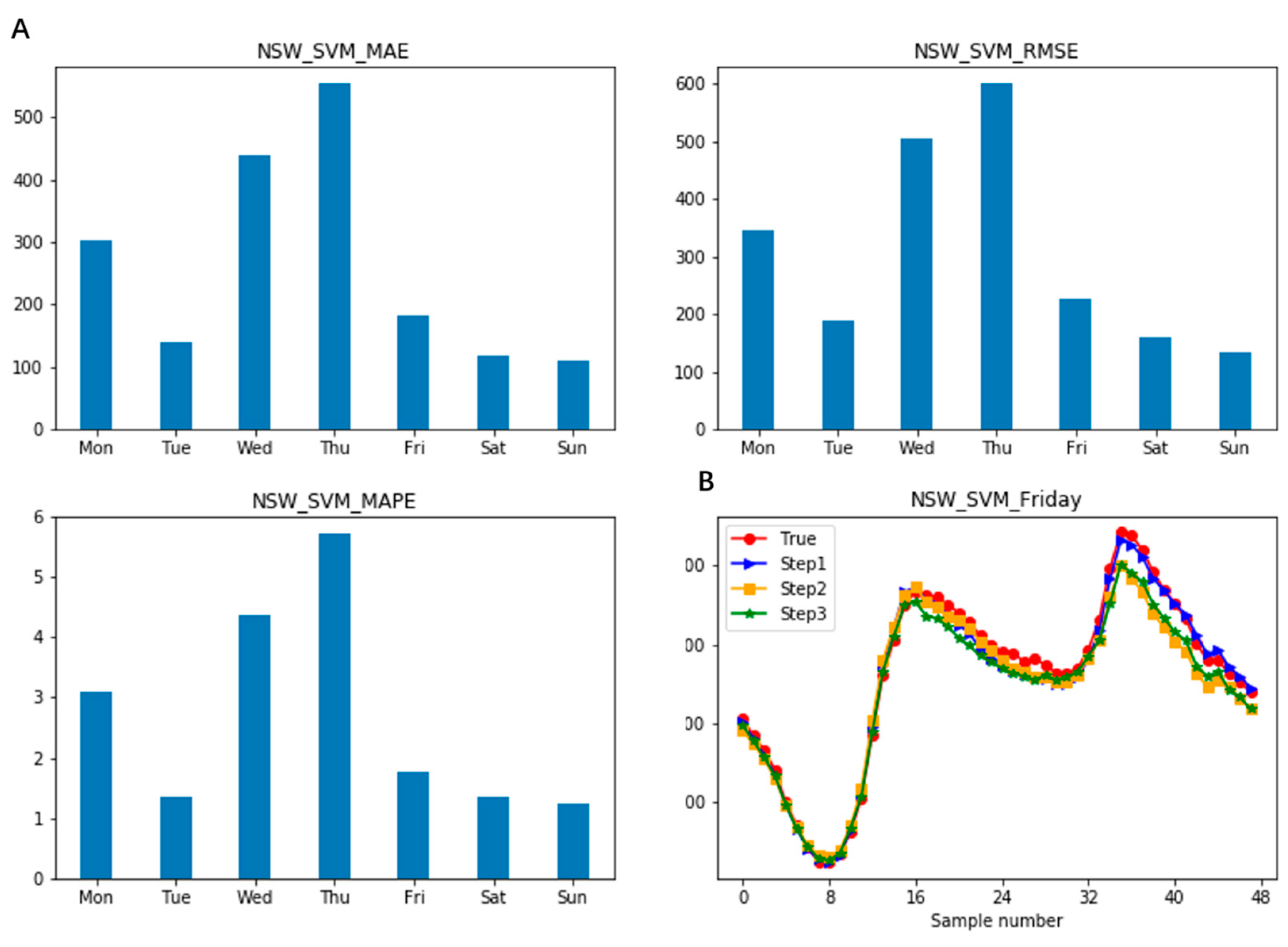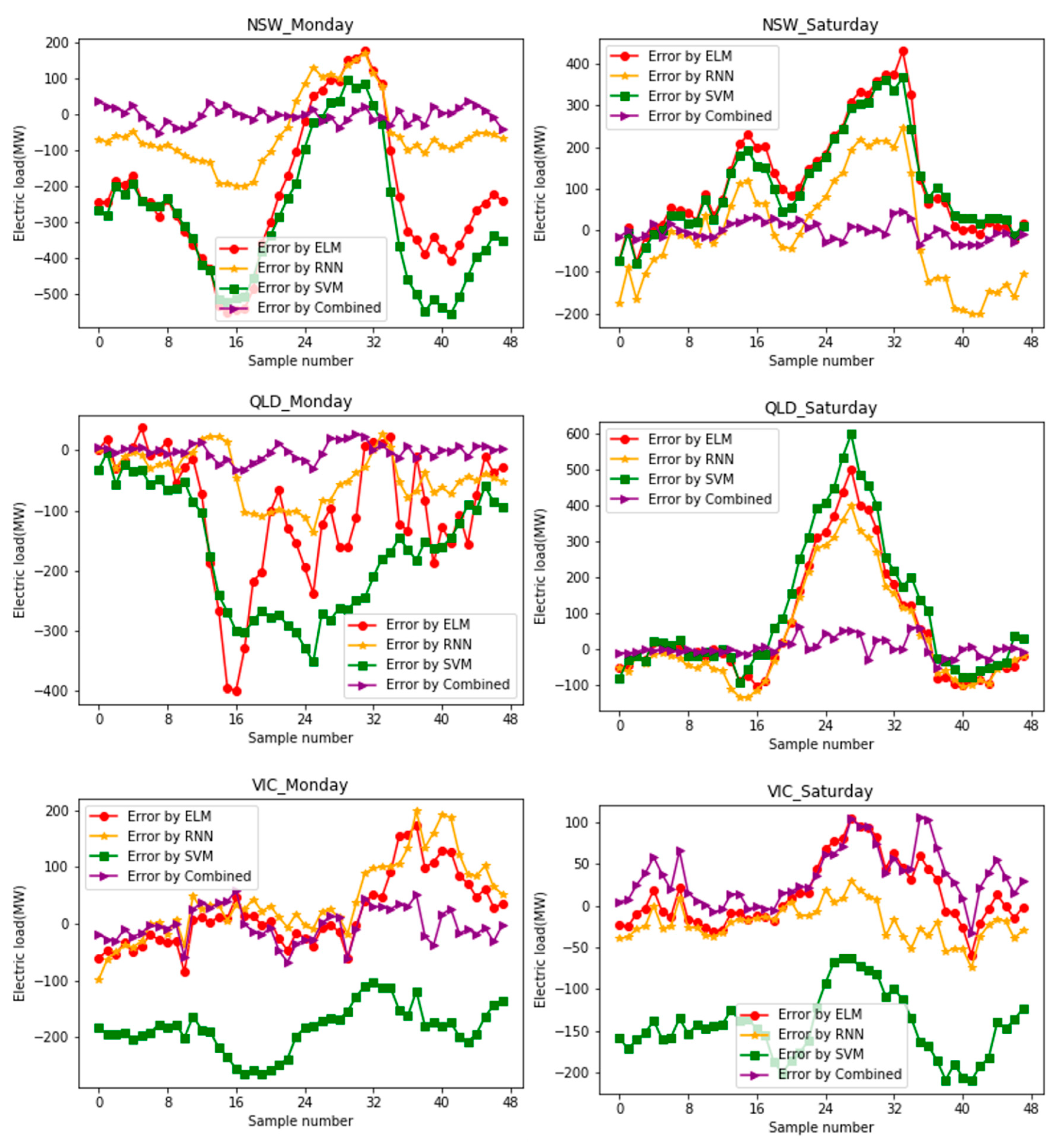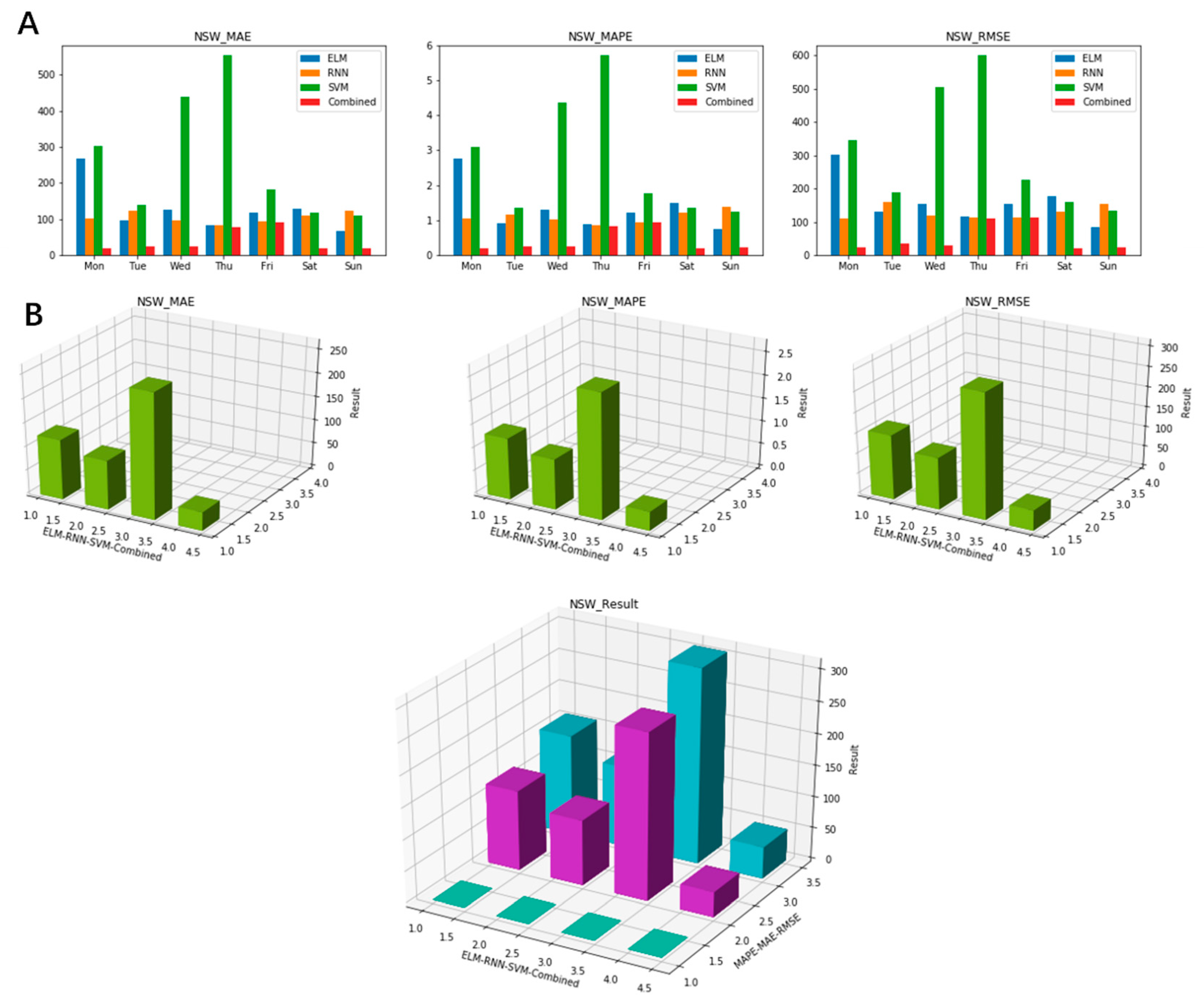Multi-Objective Particle Swarm Optimization Algorithm for Multi-Step Electric Load Forecasting
Abstract
1. Introduction
2. Related Methodology
2.1. Extreme Learning Machine
2.2. Recurrent Neural Network
2.3. Support Vector Machine
2.4. Multi-Objective Particle Swarm Optimization (MOPSO)
2.4.1. Multi-Objective Optimization
2.4.2. MOPSO
3. Proposed Model
4. Experimental Results and Discussion
4.1. Dataset
4.2. Forecasting Performance Metrics
4.3. Experimental Results and Analysis
4.3.1. The Forecasting Results of ELM
4.3.2. The Forecasting Results of RNN
4.3.3. The Forecasting Results of SVM
4.3.4. The Forecasting Results of Combined
4.3.5. The Forecasting Results of the Four Models and Comparisons
5. Conclusions
Author Contributions
Funding
Conflicts of Interest
References
- Zhang, J.; Wei, Y.M.; Li, D.; Tan, Z.; Zhou, J. Short term electricity load forecasting using a hybrid model. Energy 2018, 158, 774–781. [Google Scholar] [CrossRef]
- Velsink, H. Time Series Analysis of 3D Coordinates Using Nonstochastic Observations. J. Appl. Geod. 2016, 10, 5–16. [Google Scholar] [CrossRef][Green Version]
- Meng, M.; Wang, L.; Shang, W. Decomposition and forecasting analysis of China’s household electricity consumption using three-dimensional decomposition and hybrid trend extrapolation models. Energy 2018, 165, 143–152. [Google Scholar] [CrossRef]
- Yunishafira, A. Determining the Appropriate Demand Forecasting Using Time Series Method: Study Case at Garment Industry in Indonesia. KnE Soc. Sci. 2018, 3, 553–564. [Google Scholar] [CrossRef]
- Verma, A.; Karan, A.; Mathur, A.; Chethan, S. Analysis of time-series method for demand forecasting. J. Eng. Appl. Sci. 2017, 12, 3102–3107. [Google Scholar]
- An, Y.; Zhou, Y.; Li, R. Forecasting India’s Electricity Demand Using a Range of Probabilistic Methods. Energies 2019, 12, 2574. [Google Scholar] [CrossRef]
- Shah, I.; Iftikhar, H.; Ali, S.; Wang, D. Short-Term Electricity Demand Forecasting Using Components Estimation Technique. Energies 2019, 12, 2532. [Google Scholar] [CrossRef]
- Al-Musaylh, M.S.; Deo, R.C.; Adamowski, J.F.; Li, Y. Short-term electricity demand forecasting with MARS, SVR and ARIMA models using aggregated demand data in Queensland, Australia. Adv. Eng. Inf. 2018, 35, 1–16. [Google Scholar] [CrossRef]
- Yixian, L.I.U.; Roberts, M.C.; Sioshansi, R. A vector autoregression weather model for electricity supply and demand modeling. J. Mod. Power Syst. Clean Energy 2018, 6, 763–776. [Google Scholar]
- Yang, Y.; Chen, Y.; Wang, Y. Modelling a combined method based on ANFIS and neural network improved by DE algorithm: A case study for short-term electricity demand forecasting. Appl. Soft Comput. 2016, 49, 663–675. [Google Scholar] [CrossRef]
- Al-Musaylh, M.S.; Deo, R.C.; Li, Y. Two-phase particle swarm optimized-support vector regression hybrid model integrated with improved empirical mode decomposition with adaptive noise for multiple-horizon electricity demand forecasting. Appl. Energy 2018, 217, 422–439. [Google Scholar] [CrossRef]
- Hatori, T.; Sato-Ilic, M. A Fuzzy Clustering Method Using the Relative Structure of the Belongingness of Objects to Clusters. Procedia Comput. Sci. 2014, 35, 994–1002. [Google Scholar] [CrossRef][Green Version]
- Majkowski, A.; Kołodziej, M.; Rak, R.J. Joint Time-Frequency and Wavelet Analysis—An Introduction. Metrol. Meas. Syst. 2014, 21, 741–758. [Google Scholar] [CrossRef]
- Bento, P.M.R.; Pombo, J.A.N.; Calado, M.R.A. A bat optimized neural network and wavelet transform approach for short-term price forecasting. Appl. Energy 2018, 210, 88–97. [Google Scholar] [CrossRef]
- Koroglu, S.; Sergeant, P.; Umurkan, N. Comparison of Analytical, Finite Element and Neural Network Methods to Study Magnetic Shielding. Simul. Model. Pract. Theory 2010, 18, 206–216. [Google Scholar] [CrossRef]
- Johannesen, N.J.; Kolhe, M.; Goodwin, M. Relative evaluation of regression tools for urban area electrical energy demand forecasting. J. Clean. Prod. 2019, 218, 555–564. [Google Scholar] [CrossRef]
- Trull, Ó.; García-Díaz, J.C.; Troncoso, A. Application of Discrete-Interval Moving Seasonalities to Spanish Electricity Demand Forecasting during Easter. Energies 2019, 12, 1083. [Google Scholar] [CrossRef]
- Ceci, M.; Corizzo, R.; Malerba, D. Spatial autocorrelation and entropy for renewable energy forecasting. Data Min. Knowl. Discov. 2019, 33, 698–729. [Google Scholar] [CrossRef]
- La Rosa, M.; Rabinovich, M.I.; Huerta, R. Slow regularization through chaotic oscillation transfer in an unidirectional chain of Hindmarsh–Rose models. Phys. Lett. A 2000, 266, 88–93. [Google Scholar] [CrossRef]
- Yang, A.; Li, W.; Yang, X. Short-term electricity load forecasting based on feature selection and Least Squares Support Vector Machines. Knowl. Based Syst. 2019, 163, 159–173. [Google Scholar] [CrossRef]
- Bedi, J.; Toshniwal, D. Deep learning framework to forecast electricity demand. Appl. Energy 2019, 238, 1312–1326. [Google Scholar] [CrossRef]
- Eseye, A.T.; Lehtonen, M.; Tukia, T. Machine learning based integrated feature selection approach for improved electricity demand forecasting in decentralized energy systems. IEEE Access 2019, 7, 91463–91475. [Google Scholar] [CrossRef]
- Liu, P.; Zheng, P.; Chen, Z. Deep Learning with Stacked Denoising Auto-Encoder for Short-Term Electric Load Forecasting. Energies 2019, 12, 2445. [Google Scholar] [CrossRef]
- Singh, S.; Yassine, A. Big data mining of energy time series for behavioral analytics and energy consumption forecasting. Energies 2018, 11, 452. [Google Scholar] [CrossRef]
- Corizzo, R.; Pio, G.; Ceci, M. DENCAST: Distributed density-based clustering for multi-target regression. J. Big Data 2019, 6, 43. [Google Scholar] [CrossRef]
- Shi, J.; Guo, J.; Zheng, S. Evaluation of hybrid forecasting approaches for wind speed and power generation time series. Renew. Sustain. Energy Rev. 2012, 16, 3471–3480. [Google Scholar] [CrossRef]
- Foley, A.M.; Leahy, P.G.; Marvuglia, A. Current methods and advances in forecasting of wind power generation. Renew. Energy 2012, 37, 1–8. [Google Scholar] [CrossRef]
- Li, S.; Wang, P.; Goel, L. Short-term load forecasting by wavelet transform and evolutionary extreme learning machine. Electr. Power Syst. Res. 2015, 122, 96–103. [Google Scholar] [CrossRef]
- Zhang, X.; Wang, J.; Zhang, K. Short-term electric load forecasting based on singular spectrum analysis and support vector machine optimized by Cuckoo search algorithm. Electr. Power Syst. Res. 2017, 146, 270–285. [Google Scholar] [CrossRef]
- Xiao, L.; Wang, J.; Hou, R. A combined model based on data pre-analysis and weight coefficients optimization for electrical load forecasting. Energy 2015, 82, 524–549. [Google Scholar] [CrossRef]
- Wang, J.; Zhu, S.; Zhang, W. Combined modeling for electric load forecasting with adaptive particle swarm optimization. Energy 2010, 35, 1671–1678. [Google Scholar] [CrossRef]
- Liu, T.; Jin, Y.; Gao, Y. A New Hybrid Approach for Short-Term Electric Load Forecasting Applying Support Vector Machine with Ensemble Empirical Mode Decomposition and Whale Optimization. Energies 2019, 12, 1520. [Google Scholar] [CrossRef]
- Zhang, Y.; Wang, J.; Lu, H. Research and Application of a Novel Combined Model Based on Multiobjective Optimization for Multistep-Ahead Electric Load Forecasting. Energies 2019, 12, 1931. [Google Scholar] [CrossRef]
- Sutskever, I.; Martens, J.; Dahl, G. On the importance of initialization and momentum in deep learning. Proc. Mach. Learn. Res. 2013, 28, 1139–1147. [Google Scholar]
- Werbos, P.J. Backpropagation through time: What it does and how to do it. Proc. IEEE 1990, 78, 1550–1560. [Google Scholar] [CrossRef]
- Jin, Y.; Sendhoff, B. Pareto-based multiobjective machine learning: An overview and case studies. IEEE Trans. Syst. Man Cybern. Part C 2008, 38, 397–415. [Google Scholar]
- Moore, J. Application of Particle Swarm to Multiobjective Optimization; Technical Report; Department of Computer Science and Software Engineering, Auburn University: Auburn, AL, USA, 1999. [Google Scholar]
- Bartz-Beielstein, T.; Limbourg, P.; Mehnen, J. Particle Swarm Optimizers for Pareto Optimization with Enhanced Archiving Techniques. In Proceedings of the 2003 Congress on Evolutionary Computation (CEC’03 IEEE), Canberra, Australia, 8–12 December 2003; Volume 3, pp. 1780–1787. [Google Scholar]
- Pulido, G.T.; Coello, C.A.C. Using Clustering Techniques to Improve the Performance of a Multi-Objective Particle Swarm Optimizer. In Genetic and Evolutionary Computation Conference; Springer: Berlin/Heidelberg, Germany, 2004; pp. 225–237. [Google Scholar]
- Coello, C.A.C.; Pulido, G.T.; Lechuga, M.S. Handling multiple objectives with particle swarm optimization. IEEE Trans. Evol. Comput. 2004, 8, 256–279. [Google Scholar] [CrossRef]
- Tian, C.; Hao, Y. A novel nonlinear combined forecasting system for short-term load forecasting. Energies 2018, 11, 712. [Google Scholar] [CrossRef]
- Pelleg, D.; Moore, A. X-Means: Extending K-Means with Efficient Estimation of the Number of Clusters; Morgan Kaufmann Publishers Inc.: San Francisco, CA, USA, 2000. [Google Scholar]









| ELM | MAE | MAPE (%) | RMSE | ||||||
|---|---|---|---|---|---|---|---|---|---|
| TIME(D) | STEP1 | STEP2 | STEP3 | STEP1 | STEP2 | STEP3 | STEP1 | STEP2 | STEP3 |
| DAY1 | 180.2620 | 223.5158 | 269.0477 | 1.8829 | 2.2823 | 2.7711 | 199.3975 | 257.5034 | 301.6650 |
| DAY2 | 150.5427 | 119.5558 | 95.7808 | 1.5568 | 1.1424 | 0.9093 | 169.7331 | 152.0707 | 129.8965 |
| DAY3 | 115.4631 | 100.0074 | 127.0222 | 1.1750 | 1.0209 | 1.2884 | 134.7088 | 116.1235 | 154.6992 |
| DAY4 | 73.8332 | 70.0354 | 84.2051 | 0.7659 | 0.7316 | 0.8798 | 98.6699 | 94.7967 | 116.4148 |
| DAY5 | 110.4526 | 129.0427 | 116.5359 | 1.1288 | 1.2906 | 1.2246 | 140.7077 | 156.1950 | 154.2217 |
| DAY6 | 68.8109 | 105.4868 | 129.2183 | 0.7753 | 1.1652 | 1.4788 | 91.7127 | 134.2359 | 177.7145 |
| DAY7 | 138.0636 | 160.8418 | 66.2811 | 1.6448 | 1.8433 | 0.7571 | 207.5540 | 180.5958 | 84.2173 |
| RNN | MAE | MAPE (%) | RMSE | ||||||
|---|---|---|---|---|---|---|---|---|---|
| TIME(D) | STEP1 | STEP2 | STEP3 | STEP1 | STEP2 | STEP3 | STEP1 | STEP2 | STEP3 |
| DAY1 | 204.1581 | 100.5311 | 101.6679 | 2.0580 | 1.0004 | 1.0509 | 213.0676 | 161.3429 | 110.6075 |
| DAY2 | 98.1426 | 167.0452 | 122.8477 | 0.9296 | 1.6683 | 1.1735 | 134.0583 | 182.9610 | 160.6650 |
| DAY3 | 121.8523 | 72.2479 | 97.6225 | 1.2474 | 0.7655 | 1.0284 | 139.6238 | 85.7970 | 118.0915 |
| DAY4 | 67.4409 | 67.5249 | 82.0695 | 0.6929 | 0.7009 | 0.8547 | 93.1168 | 93.0551 | 113.8564 |
| DAY5 | 114.3743 | 95.8134 | 92.7150 | 1.1588 | 0.9740 | 0.9485 | 136.1701 | 113.4121 | 114.0553 |
| DAY6 | 76.4809 | 109.1112 | 109.3341 | 0.8619 | 1.2323 | 1.2266 | 103.1139 | 136.8135 | 129.6750 |
| DAY7 | 110.8216 | 82.7990 | 121.9677 | 1.2929 | 1.0041 | 1.3783 | 130.8743 | 114.4017 | 153.7139 |
| SVM | MAE | MAPE (%) | RMSE | ||||||
|---|---|---|---|---|---|---|---|---|---|
| TIME(D) | STEP1 | STEP2 | STEP3 | STEP1 | STEP2 | STEP3 | STEP1 | STEP2 | STEP3 |
| DAY1 | 180.0960 | 172.5924 | 303.2188 | 1.8099 | 1.7267 | 3.0852 | 210.2919 | 198.6691 | 346.2488 |
| DAY2 | 72.6219 | 109.3225 | 140.4559 | 0.7714 | 1.1231 | 1.3460 | 86.1632 | 122.1922 | 187.4571 |
| DAY3 | 209.4914 | 144.2640 | 439.0666 | 2.0744 | 1.4769 | 4.3661 | 238.7288 | 174.8522 | 506.0270 |
| DAY4 | 82.9948 | 86.9796 | 554.5602 | 0.8716 | 0.9158 | 5.7218 | 104.0347 | 109.1755 | 109.1755 |
| DAY5 | 96.6003 | 191.0145 | 181.1285 | 0.9776 | 0.9776 | 1.7755 | 112.0442 | 240.2994 | 225.3321 |
| DAY6 | 78.3938 | 192.2528 | 118.7355 | 0.8883 | 2.1899 | 1.3550 | 110.0911 | 229.1995 | 161.0205 |
| DAY7 | 55.2772 | 274.7910 | 110.1746 | 0.6406 | 3.1098 | 1.2377 | 68.5575 | 345.1129 | 133.3524 |
| MIX | MAE | MAPE | RMSE | ||||||
|---|---|---|---|---|---|---|---|---|---|
| TIME (D) | STEP1 | STEP2 | STEP3 | STEP1 | STEP2 | STEP3 | STEP1 | STEP2 | STEP3 |
| DAY1 | 37.6589 | 19.5080 | 18.2669 | 0.3918 | 0.2034 | 0.2000 | 49.7642 | 23.9760 | 22.5024 |
| DAY2 | 37.0253 | 23.7493 | 23.7493 | 0.3799 | 0.2410 | 0.2489 | 48.6672 | 29.3704 | 34.0105 |
| DAY3 | 12.1504 | 72.1446 | 24.5223 | 0.1237 | 0.7644 | 0.2590 | 15.1244 | 85.6886 | 29.7709 |
| DAY4 | 67.5954 | 66.6814 | 78.9236 | 0.6936 | 0.6952 | 0.8216 | 93.3445 | 90.1175 | 110.0905 |
| DAY5 | 115.3340 | 95.7731 | 92.0974 | 1.1687 | 0.9752 | 0.9449 | 136.8067 | 114.1894 | 113.5286 |
| DAY6 | 79.2139 | 33.5431 | 18.1808 | 0.8916 | 0.3738 | 0.2037 | 105.8659 | 44.0796 | 21.6340 |
| DAY7 | 25.2162 | 18.4378 | 18.6716 | 0.3014 | 0.2120 | 0.2177 | 31.9761 | 22.2866 | 22.6853 |
| Date | Monday | Tuesday | Wednesday | Thursday | Friday | Saturday | Sunday | Average |
|---|---|---|---|---|---|---|---|---|
| MAE | ||||||||
| ELM | 106.7967 | 430.4047 | 124.4383 | 248.7430 | 137.0113 | 119.1218 | 232.6718 | 199.8839 |
| RNN | 49.4061 | 51.9644 | 96.5393 | 105.4656 | 135.3078 | 114.5491 | 132.4774 | 97.9585 |
| SVM | 169.2212 | 130.8537 | 74.2149 | 223.3669 | 210.5455 | 139.9597 | 202.0815 | 164.3205 |
| Combined | 10.3468 | 45.7838 | 51.5260 | 79.4087 | 103.8398 | 17.2876 | 122.8888 | 61.5831 |
| RMSE | ||||||||
| ELM | 146.4229 | 622.5072 | 195.6884 | 329.6401 | 206.9160 | 177.1841 | 330.4177 | 286.9681 |
| RNN | 61.1178 | 78.9962 | 129.8775 | 141.4667 | 188.2211 | 153.6274 | 189.4702 | 134.6824 |
| SVM | 196.0913 | 169.0187 | 106.3683 | 340.2963 | 328.5419 | 215.5059 | 308.1820 | 237.7149 |
| Combined | 13.5202 | 60.0425 | 79.8899 | 98.0779 | 133.2788 | 25.3522 | 172.3644 | 83.2180 |
| MAPE (%) | ||||||||
| ELM | 1.6979 | 6.6900 | 1.9441 | 4.1041 | 2.2723 | 2.1641 | 4.3466 | 3.3170 |
| RNN | 0.7952 | 0.8301 | 1.5119 | 1.7711 | 2.2433 | 2.0834 | 2.4881 | 1.6747 |
| SVM | 2.7228 | 2.0697 | 1.1872 | 3.7387 | 3.5043 | 2.5591 | 3.8490 | 2.8044 |
| Combined | 0.1681 | 0.7346 | 0.8177 | 1.3294 | 1.7087 | 0.3037 | 2.2958 | 1.0511 |
© 2020 by the authors. Licensee MDPI, Basel, Switzerland. This article is an open access article distributed under the terms and conditions of the Creative Commons Attribution (CC BY) license (http://creativecommons.org/licenses/by/4.0/).
Share and Cite
Yang, Y.; Shang, Z.; Chen, Y.; Chen, Y. Multi-Objective Particle Swarm Optimization Algorithm for Multi-Step Electric Load Forecasting. Energies 2020, 13, 532. https://doi.org/10.3390/en13030532
Yang Y, Shang Z, Chen Y, Chen Y. Multi-Objective Particle Swarm Optimization Algorithm for Multi-Step Electric Load Forecasting. Energies. 2020; 13(3):532. https://doi.org/10.3390/en13030532
Chicago/Turabian StyleYang, Yi, Zhihao Shang, Yao Chen, and Yanhua Chen. 2020. "Multi-Objective Particle Swarm Optimization Algorithm for Multi-Step Electric Load Forecasting" Energies 13, no. 3: 532. https://doi.org/10.3390/en13030532
APA StyleYang, Y., Shang, Z., Chen, Y., & Chen, Y. (2020). Multi-Objective Particle Swarm Optimization Algorithm for Multi-Step Electric Load Forecasting. Energies, 13(3), 532. https://doi.org/10.3390/en13030532




